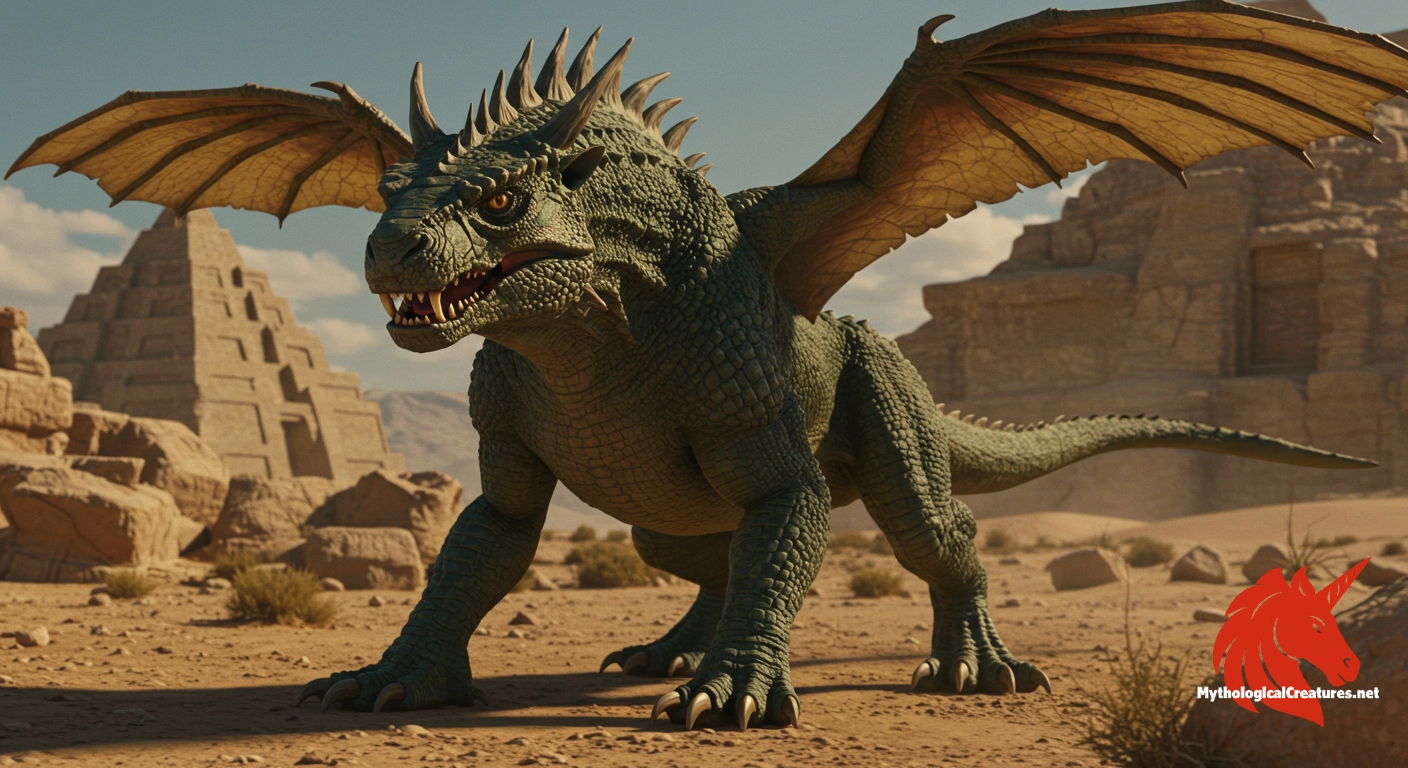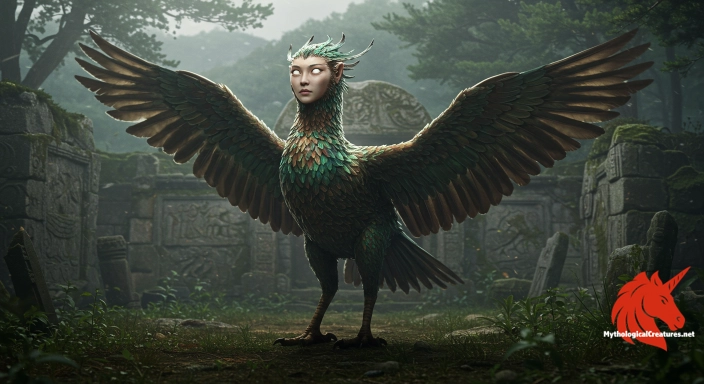Ušumgallu: Ušumgallu, also known as the Great Dragon, is a mythological horned serpent from Akkadian mythology.

Ušumgallu
Ušumgallu - Represents the fusion of serpentine and leonine qualities in a demonic form, illustrating the complexity of mythological dragons in ancient Mesopotamian culture.
Origins & First Encounters
Ušumgallu is a legendary creature that emerges from the rich tapestry of ancient Mesopotamian myth, where it is revered as a formidable lion‐dragon demon. Its very name, meaning 'Great Dragon', hints at a profound cosmological significance that resonated among early Sumerian and Akkadian cultures. The creature first appears in texts dating back to the late 3rd millennium BCE, intertwining myth with the early development of cuneiform writing. It is portrayed as one of the three horned snakes in Akkadian lore, a detail that underscores its unique position in the ancient pantheon of enigmatic beings. Ancient artisans and priests imbued Ušumgallu with attributes drawn from both terrestrial and celestial symbolism, reflecting the multifaceted nature of divine and natural forces. The image of the creature often overcame traditional boundaries, merging the ferocity of the lion with the serpentine allure of the dragon. Intricately depicted in seals and cylinder impressions, its presence in ritual contexts has been linked with both protective magic and warnings of cosmic imbalance. The enduring myths of Ušumgallu highlight a belief in the interconnectedness between human fate and the mysterious forces governing nature. Its legendary status continues to inspire modern reinterpretations, ensuring that the echoes of its ancient origins remain a subject of scholarly and cultural fascination.
Source Texts & Tale Variants
Ancient texts and artefacts provide a window into the diverse narratives surrounding Ušumgallu, revealing multiple layers of mythic tradition. Ritual incantations, magical prescriptions, and decorative cylinder seals serve as some of the primary sources that bring this creature to life. In these documents, Ušumgallu is often mentioned alongside other mythical beings, emphasising its role within a triad of horned serpents. Variants of its story depict it as a guardian of the cosmic order, while other texts highlight its association with chaotic forces. Some narrative traditions present the creature in an almost totemic role, entwined with both protective and destructive energies. Moreover, certain versions amplify its attributes as a lion-dragon, merging iconography of multiple animals into one emblematic figure. Fragments of the incantations suggest that the creature might have been invoked to ward off evil or to bestow blessings in ritual settings. Differences in narrative detail hint at regional adaptations, where local mystics tailored the myth to suit their cultural and spiritual needs. This amalgamation of sources not only reflects the complexity of ancient myth-making but also invites ongoing reinterpretation in the study of early Mesopotamian legends.
Form & Powers
Ušumgallu is depicted with a striking anatomy that intricately blends the features of both lion and dragon, resulting in a creature that is both awe-inspiring and formidable. One of its most distinctive characteristics is the presence of three prominent horns, which serve as potent symbols of supernatural might and authority. The body is adorned with scales that reflect an iridescent sheen, reminiscent of burnished metal glinting in the sun. Its face merges the noble ferocity of a lion with the sinuous, cunning expression of a serpent, offering a visage that is at once regal and menacing. Early representations suggest that the creature possessed four sturdy legs and an impressive pair of wings, elements that add to its majestic and predatory presence. The textures applied in artistic depictions often illuminate details such as a flowing mane or intricate crest, each design crafted to evoke divine protection or divine wrath. A long, undulating tail sometimes completes its form, echoing the flowing patterns of ancient rivers and symbolising continuity. Elaborate carvings further embellish its body with ornamental motifs that weave in cosmic and natural symbolism. These visual details collectively construct an image that is as much a spiritual emblem as it is an artistic marvel.
Regional Faces
The portrayal of Ušumgallu indeed varies across different regions of ancient Mesopotamia, adapting to local customs and artistic sensibilities. In urban centres of the Akkadian heartland, the creature is often cast in the role of a majestic guardian, its regal features emphasised to support royal iconography and divine legitimacy. In more remote or border areas, the emphasis shifts to its wilder, chaotic attributes, reflecting local interpretations of nature’s unpredictable forces. Some local traditions accentuate its leonine aspects, while others focus on its serpentine qualities, demonstrating a flexible integration into regional myth. Variations in the creature’s attire and decorative patterns indicate a deliberate melding of native symbolism with broader Mesopotamian artistic traditions. Local perceptions sometimes frame Ušumgallu as a harbinger of natural phenomena, such as storms or droughts, linking its appearance with environmental omens. Regional artisans have been known to incorporate indigenous motifs alongside the creature’s standard iconography, thereby creating a unique visual language. Such adaptations underscore the dynamic relationship between myth, geography, and cultural identity. This regional diversity ensures that Ušumgallu remains a multifaceted emblem, continually reinterpreted to meet the spiritual needs and aesthetic tastes of diverse communities.
Cultural Parallels
The myth of Ušumgallu resonates with a broader, cross-cultural fascination for dragon-like creatures, forging intriguing parallels with legends well beyond Mesopotamia. Its composite nature, merging lion and serpent, invites comparisons with entities from both Eastern and Western mythologies, such as the benevolent yet formidable Chinese dragons. Other cultures have crafted narratives around multi-headed or horned serpents that, like Ušumgallu, symbolise a bridge between order and chaos. In Europe, the image of the dragon as both a guardian and a harbinger of doom mirrors the dualistic portrayal seen in ancient Near Eastern accounts. Many mythic traditions elevate creatures with a hybrid anatomy to a status that straddles the line between mortal and divine, an approach also evident in Ušumgallu’s depiction. The incorporation of multiple animal traits serves as a universal symbolic language, conveying power, danger, and cosmic mystery. Artistic depictions from different cultures often employ a similar visual lexicon, blending features of predatory felines with serpentine agility. This comparative analysis highlights not only shared human concerns about the forces of nature but also the desire to encapsulate these forces in mythic narratives. Ultimately, Ušumgallu stands as a testament to a pervasive archetype of the great dragon, bridging disparate cultural narratives through its enduring symbolisms.
Legacy & Modern Evolution
Over the centuries, the image of Ušumgallu has undergone significant transformations, tracing a path from ancient invocations to modern cultural iconography. Its early representations in Sumerian and Akkadian art provided a foundation upon which later generations built more elaborate and symbolic portrayals. When its imagery re-emerged in later periods, particularly during the Middle Ages, it contributed to the iconic dragon motifs that have since permeated European folklore and fantasy literature. The evolution of Ušumgallu’s depiction reflects shifting societal perceptions of power, divinity, and the natural world, with its fearsome visage adapting to meet new narrative needs. Today, the creature is often reimagined in contemporary media as an emblem of both mythic terror and mystical wisdom, symbolising the eternal battle between order and chaos. Modern adaptations have frequently drawn on its ancient iconography to create rich, layered narratives in books, films, and artistic installations. Even as scholarly interpretation continues to evolve, Ušumgallu remains a potent reminder of humanity’s longstanding engagement with the unknown. Its legacy is celebrated in academic circles and popular culture alike, where it serves as a bridge linking the ancient past with modern myth-making. The continual reinvention of Ušumgallu underscores how enduring symbols can adapt over time, maintaining relevance through an ever-changing cultural landscape.
Interesting Fact
An interesting aspect of Ušumgallu is its association with two other horned snakes, Bašmu and Mušmaʿbū, which underscores the prominence of serpentine symbolism in Akkadian mythology.
Quick Creature Info
Origin:
Our Mythic Legendary Rating:

Also Sometimes Known As:
Habitat:
Supernatural Powers:
Physical Attributes:
Abilities:
Behavior:
Lore:
Related Creatures, Tales or Lore
- TTiamat
- SSirrush
- LLeviathan
References
Discover Another Mythical Legend You May Not Have Heard Of?
Uncover the mysteries of ancient folklore and expand your knowledge of legendary beings from cultures around the world.
Dare to Meet the Inmyeonjo....
Mythical Disclaimer: The images and data on this site are derived from various historical and literary sources, but we have found that many myths often have multiple versions and interpretations across references, sometimes contradictory. As a result, these creature depictions are artistic interpretations—imaginative blends of folklore, legend, and a dash of AI guesswork. Because creature descriptions vary widely, our illustrations and accompanying information represent our best effort to honor mythology while bridging creative gaps. Enjoy these interpretations—just remember, we've done our best to respect the stories and validate available data, but in the realm of mythology, details often shift, imagination leads the way, and nothing is ever set in stone!
Curated by the Mythological Creatures Team (rev. May 2025)
